- Home
- Stephen E. Ambrose
The Men of World War II Page 3
The Men of World War II Read online
Page 3
The second day it took some miles for stiff, aching muscles to warm up, but the third day was the worst. With 80 miles covered, there were still 38 to go, the last 20 or so on the highway leading into Atlanta. Marching in mud had been bad, but the cement was much worse on the feet. The battalion camped that night on the grounds of Oglethorpe University, on the outskirts of Atlanta.
Malarkey and his buddy Warren “Skip” Muck put up their pup tent and lay down to rest. Word came that chow was ready. Malarkey could not stand up. He crawled on his hands and knees to the chow line. His platoon leader, Winters, took one look and told him to ride in an ambulance the next morning to the final destination, Five Points in downtown Atlanta.
Malarkey decided he could make it. So did nearly all the others. By this time the march had generated publicity throughout Georgia, on the radio and in the newspapers. Cheering crowds lined the route of march. Strayer had arranged for a band. It met them a mile from Five Points. Malarkey, who had struggled along in terrible pain, had “a strange thing happen to me when that band began to play. I straightened up, the pain disappeared, and I finished the march as if we were passing in review at Toccoa.”
They had covered 118 miles in 75 hours. Actual marching time was 33 hours, 30 minutes, or about 4 miles an hour. Of the 586 men and officers in the battalion, only twelve failed to complete the march, although some had to be supported by comrades the last day. Colonel Sink was appropriately proud. “Not a man fell out,” he told the press, “but when they fell, they fell face forward.” Lieutenant Moore’s 3d platoon of Easy was the only one in the battalion in which every man walked every step of the way on his own. As a reward, it led the parade through Atlanta.
* * *
1. Kurt Gabel, The Making of a Paratrooper: Airborne Training and Combat in World War II (Lawrence, Kan.: University of Kansas, 1990), 142.
2. J. Glenn Gray, The Warriors: Reflections on Men in Battle (New York: Harper & Row, 1959), 43, 45, 46.
3. Paul Fussell, Wartime: Understanding and Behavior in the Second World War (New York: Oxford University Press, 1989), 80.
4. Ibid.
2
“Stand Up and Hook Up”
BENNING, MACKALL, BRAGG, SHANKS
December 1942–September 1943
BENNING WAS, if possible, even more miserable than Toccoa, especially its infamous Frying Pan area, where the jump training went on. This was the regimental bivouac area, consisting of scrubby little wooden huts set on barren, sandy soil. But Benning was a welcome relief to the men of E Company in the sense that they were getting realistic training for becoming paratroopers rather than spending most of their waking hours doing physical exercises.
Parachute school was supposed to begin with physical training (A stage), followed by B, C, and D stages, each lasting a week, but the 506th skipped A stage. This happened because the 1st Battalion arrived ahead of the others, went into A stage, and embarrassed the jump school sergeants who were assigned to lead the calisthenics and runs. The Toccoa graduates would laugh at the sergeants. On the runs they would begin running backward, challenge the sergeants to a race, ask them—after a couple of hours of exercises that left the sergeants panting—when they were going to get past the warm-up and into the real thing. After two days of such abuse, the sergeants told the C.O. that the 506th was in much better physical condition than they were, so all the companies of the 506th started in immediately on B stage.
For a week, the company double-timed each morning to the packing sheds, where the men learned how to fold and pack their parachutes. They ran back to the Frying Pan for lunch, then spent the afternoon leaping into sawdust piles from mock doors on dummy fuselages raised 4 feet off the ground, handling parachutes on a suspended harness, or jumping off 30-foot towers in parachute harnesses suspended from a steel cable.
The following week, in C stage, the men made free and controlled jumps from the 250-foot towers. One tower had seats, shock absorbers, and chute guide wires; the others had four chutes that released when they reached the suspension arm. From these, each man made several daylight jumps and one at night.
C stage also featured a wind machine, which blew a gale along the ground, moving both chute and jumper to teach the men how to control and collapse their canopies after landing.
After a week at the towers, the enlisted men were ready for D stage, the real thing, the five jumps from a C-47 that would earn those who completed the process their parachutists’ wings. The men packed their chutes the night before, checked them, then packed them again, checked them again, until past 2300. Reveille was at 0530. They marched to the hangers at Lawson Field, singing and shouting in anticipation. They put on their chutes, then sat on rows of benches waiting to be summoned to the C-47s. There was joshing, joke telling, lots of smoking, nervous laughter, frequent trips to the latrine, and repeated checking of the chute and the reserve chute worn on the chest.
They loaded up, twenty-four to a plane. With only one or two exceptions, it was the first plane ride for the men. When the C-47 reached 1,500 feet, it circled. The red light went on; the jumpmaster, a sergeant instructor, called out, “Stand up and hook up.” Each man hooked the line attached to the backpack cover of his main chute to the anchor line running down the middle of the top of the fuselage.
“Sound off for equipment check!” shouted the jumpmaster.
“Number twelve O.K.!” “Number eleven O.K!” and so on down the line.
“Close up and stand in the door!”
The first man stepped up to the open door. All the men had been ordered to look out at the horizon, not straight down, for obvious psychological reasons. They had also been taught to place their hands on the outer edge of the door, never on the inside. With the hands on the outside, there was nothing to hold a man in the plane, and the slightest nudge, even just the sense of the next man pressing forward, would be enough to get him out of the plane. If he tried to steady himself by putting his hands on the inside, as Gordon said, “twelve men behind couldn’t push that fellow out of there if he didn’t want to go. That’s the power of fear.” When a jumpmaster saw a man put his hands on the inside, he would pull him back and let the others go out.
Most of the men, according to Gordon, “were so psyched up and in the swim of this thing that we would almost have gone out without a parachute. It was almost that bad.” Overall, 94 percent of the men of the 506th qualified, which set a record that still stands.
On the first jump, the men went one at a time. As soon as he was in the door, the jumpmaster tapped him on the leg. Out he went.
“I shuffled up to the door and leaped into a vast, breathtaking void,” Webster remembered. “My heart popped into my mouth, my mind went blank.” The static line attached to the hook on the anchor line in the plane pulled the back cover off his main chute; a break cord, tied to the apex of the chute, pulled the canopy out of the pack and then parted. The prop blast inflated the chute, and he felt the terrific opening shock.
“From then on the jump was fun. I drifted down, oscillating, or, as civilians would say, swinging to and fro, and joyously looking around. The sky was filled with high-spirited troopers shouting back and forth.”
• • •
Standing in that open door was an obvious moment of truth. Men who had been outstanding in training, men who later won medals for bravery in combat as ordinary infantry, would freeze. Sometimes they were given a second chance, either on that flight after the others had jumped, or the next day. Usually, however, if a man froze once, he would never jump.
Two members of E Company froze. They refused to jump. One of them, Pvt. Joe Ramirez, was pushed to the back of the plane, but after everyone jumped out, he told the jumpmaster that he wanted to jump. The plane circled the field. On the second pass, he jumped. As Pvt. Rod Strohl put it, “That took more guts than for a guy to go out the first time.”
• • •
Easy made its second jump that afternoon, with the men again going out one at a time. The
next jump was a mass affair, the jumpmaster shouting “Go! Go! Go!” as the twelve men in the stick moved into the doorway. The sticks cleared the plane in six seconds, to the astonishment of the jumpmaster. Carson wrote in his diary, “I think I am getting jump crazy because when I am on the ground I think of the thrill of jumping and I want to jump some more. When I feel that opening jerk, I shout with all my might.”
The fourth jump came on Christmas Eve. On Christmas Day, the company got the day off and a nice turkey feast. It was the first Christmas away from home for virtually every man in the company. Carson wrote, “It don’t seem like Christmas, no snow, no tree, no presents, no mom and dad.”
On December 26, the last jump, each man got a certificate declaring that he was “entitled to be rated from this date as a qualified Parachutist.” Then the proudest moment of all, the one toward which they had been working for six months, the pinning on of the silver wings. From that moment, never to be forgotten, each member of Easy, every member of the 506th, was forever special.
• • •
Colonel Sink held a regimental parade, then gathered the men around him. Standing on a platform, he read out an order of the day (the men later got printed copies). “You are a member of one of the finest regiments in the United States Army,” Sink declared, “and consequently in the world.” He said he was sending them home on a ten-day furlough, and reminded them that there were “certain things that are expected of you—not only while on furlough, but also a creed by which you are expected to govern your life.” They should walk with pride and military bearing, take care of their personal appearance, and “Remember our battle-cry and motto, ‘Currahee,’ and its meaning: ‘Standing Alone.’ We Stand Alone Together.”
He ordered the men to “Stay out of jail,” and dismissed them. Wearing their wings, their boots polished, the trousers bloused into the boots, off they went. When they got home, they were objects of wonder to their parents and friends, obviously because of their physical fitness, but even more because of the self-confidence they had acquired in the past half year. They had been through a training course that three out of five volunteers could not complete; they had survived Sobel’s wrath and harassment; they had jumped out of an airplane in flight. They were elite.
Not so elite, however, that they were free to ignore Army rules and regulations. Colonel Sink had warned them to get back to Benning when the furlough was up, but what with the inadequacies of the air, rail, and bus transportation systems in America in January 1943, an alarming number of the 506th were late reporting back for duty.
Colonel Sink held a regimental parade. The men turned out in their class A, or dress, uniforms. They were marched down a sandy street to an empty lot behind the cooks’ hutments. Sink called them to attention, then gave the command “At ease.” They watched and listened in silence as a lieutenant read a list of names, one from each company, from among the men who had reported in last.
“Private John Doe, E Company,” the lieutenant called out. A drummer, standing beside the lieutenant, beat a soft, mournful roll. Two sergeants, bearing submachine-guns, moved to Private Doe. He stepped from the ranks. His face was pale. The sergeants, one on each side, escorted him forward. The drum continued to roll. They stopped in front of the lieutenant. He read out the orders. Private Doe was being drummed out of the paratroopers, condemned to the infantry.
The lieutenant ripped the 506th patch from the private’s arm, the wings from his chest, the parachute patch from his hat, and threw them all on the ground. It was so humiliating that the officers and men were cursing under their breath. Webster wrote his mother, “One thing stirred us all up to a fighting madness; some cheap lieutenant without any sense of decency or good taste stood beside the drummer, snapping pictures of all the fellows who came up. Bad enough to be humiliated before your friends, but to be photographed in your disgrace—that lieutenant ought to be shot.”
There was more. A jeep drove up and dumped out Private Doe’s barracks bags. He had to take off his boots, put on regular shoes, wear his pants down like a regular infantryman (“straight legs,” as the paratroopers called them). He picked up his bags and, followed by the sub-machine-gunners, marched sadly away, the drum continuing to roll, a picture of bleak loneliness. This was repeated nine times.
After that, the 506th had little problem with men returning late from a furlough.
• • •
In late January, Easy and the rest of the 506th moved across the Chattahoochee River to the Alabama side of Fort Benning. It was like going from prison to freedom. The barracks were comfortable and the food good. There was a fine PX and a movie theater. The training concentrated on squad problems, especially house-to-house fighting, which was fun, with lots of explosions, firing blanks at one another, tossing smoke grenades. The men made their sixth jump, the first with rifles.
Carson’s diary entries capture the flavor of those winter days. February 8: “Last night we were in a hell raising mood, so we tore the barracks apart in a pillow fight. After three hours of fighting we finally decided that we were tired and went to bed.”
February 11: “[Cpl. Joe] Toye, [Sgt. George] Luz, and I to Columbus. Called up the girls and had a party, fun and more fun. Sometime during the party I ran into Betty the Key to Columbus. We finally had to get home, and got here 4:45 A.M.” February 12: “Back to Chickasaw Gardens in Columbus and another lovely evening. Betty and I hit it off swell. Really had fun. Got home at 4:45 A.M. and went on duty at 5:30 with one eye open.”
• • •
In March, it was “pack ’em up, we’re moving out.” Camp Mackall, North Carolina, was a marvel of wartime construction. On November 7, 1942, it consisted of 62,000 acres of wilderness. Four months later it had 65 miles of paved roads, a 1,200-bed hospital, five movie theaters, six huge beer gardens, a complete all-weather airfield with three 5,000-foot runways, and 1,750 buildings. The barracks were heated; the cots had mattresses. It was named for Pvt. John T. Mackall of the 82d Airborne Division, the first American paratrooper to be killed in combat in World War II. He died on November 8, the day construction began, in North Africa. Camp Mackall was home to the Airborne Command.
Training intensified and became more sophisticated. The jumps now included not only rifles, but other small arms. The bazooka had to be jumped in one piece, the light machine-guns also (although the tripod could be separated and carried by a second man). Two men split the 60 mm mortar and its base plate. Food, ammunition, maps, hand grenades, high explosives, and more were attached to the paratroopers. Some men were jumping with 100 extra pounds.
After the jumps, there were two- and three-day exercises in the woods, with the main focus on quick troop movements and operating behind enemy lines as large forces. At dusk, platoon leaders were shown their location on maps, then told to be at such-and-so by morning.
Captain Sobel made Pvt. Robert “Popeye” Wynn his runner. He sent Wynn out to locate his platoons. Wynn managed to get “lost,” and spent the night catching up on his sleep. In the morning, Sobel demanded to know why Wynn got lost.
“Because I can’t see in the dark,” Wynn replied.
“You had better learn to see in the dark,” Sobel rejoined, and sent Wynn back to his squad, replacing him with Ed Tipper as runner. “With my help,” Tipper recounted, “Sobel was able to mislay his maps, compass, and other items when he most needed them. He was getting similar ‘assistance’ from others and was disoriented and lost even more than usual. We were all hoping that he’d screw up so badly that he’d be replaced and we wouldn’t have to go into combat under his command.”
“Your rifle is your right arm!” Sobel would tell his men. “It should be in your possession every moment.” On one night exercise he decided to teach his men a lesson. He and Sergeant Evans went sneaking through the company position to steal rifles from sleeping men. The mission was successful; by daylight Sobel and Evans had nearly fifty rifles. With great fanfare, Evans called the company together and Sobel began to te
ll the men what miserable soldiers they were.
As he was yelling, the C.O. of Fox Company, accompanied by some forty-five of his men, came up. To Sobel’s great embarrassment, it turned out that he and Evans had been lost, strayed into Fox Company’s bivouac area, and stolen their rifles.
A couple of weeks later, Sobel hurt his feet on a jump. He and Sergeant Evans returned to barracks while the company stayed in the field. The captain and the first sergeant conducted a private inspection. They searched through all the footlockers, clothing, and personal possessions of the men of E Company. They went through pockets, broke open boxes, rifled letters from girlfriends and family, and confiscated all items they considered contraband. “I don’t know what the hell they were looking for,” Gordon Carson commented. “Those were the days before drugs.”
Sobel posted a list identifying the contraband, the offender, and the punishment. The men returned from the field exercise, exhausted and filthy, to find that everything they thought of as personal property was in disarray, underwear, socks, toothpaste and toothbrushes, all piled up on top of the bunks. Many items were missing.
Nearly every soldier had something confiscated. Generally it was unauthorized ammunition, nonregulation clothing, or pornography. Cans of fruit cocktail and sliced peaches, stolen from the kitchen, were gone, along with expensive shirts, none of it ever returned. One soldier had been collecting prophylactic kits. A few condoms were evidently acceptable, but 200 constituted contraband; they were posted on Sobel’s list of confiscated items.
“That marked a turning point for me,” Tipper recalled. “Before Sobel’s raid I had disliked him but had not really hated the man. Afterward I decided Sobel was my personal enemy and I did not owe him loyalty or anything else. Everyone was incensed.”

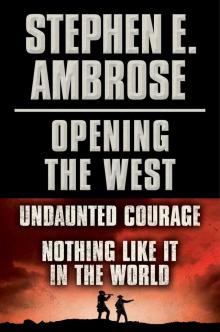 Undaunted Courage
Undaunted Courage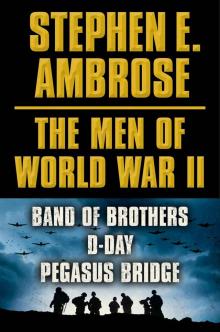 The Victors: Eisenhower and His Boys
The Victors: Eisenhower and His Boys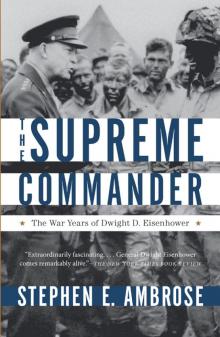 The Supreme Commander
The Supreme Commander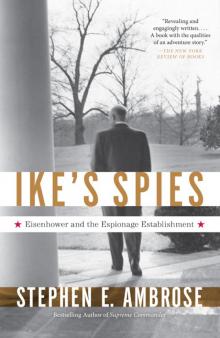 Ike's Spies: Eisenhower and the Espionage Establishment
Ike's Spies: Eisenhower and the Espionage Establishment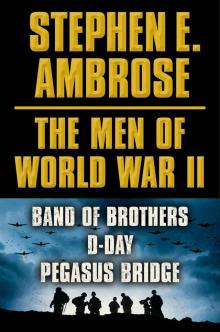 The Men of World War II
The Men of World War II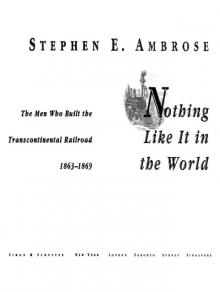 Nothing Like It in the World The Men Who Built the Transcontinental Railroad 1863-1869
Nothing Like It in the World The Men Who Built the Transcontinental Railroad 1863-1869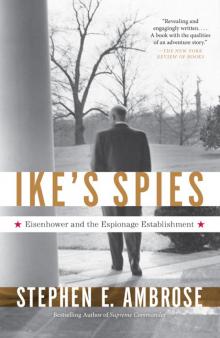 Ike's Spies
Ike's Spies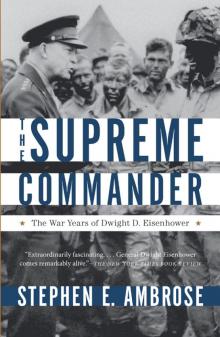 Supreme Commander
Supreme Commander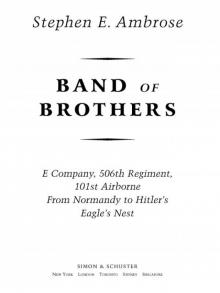 Band of Brothers
Band of Brothers